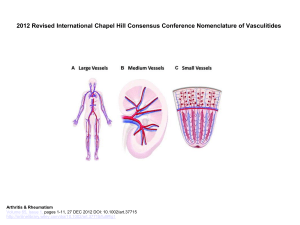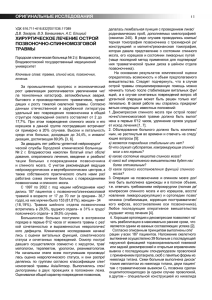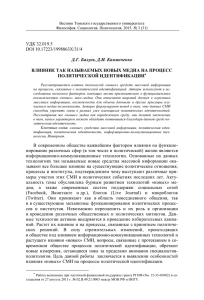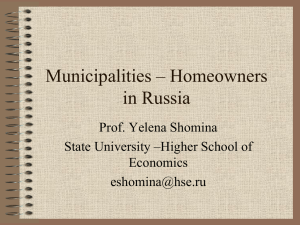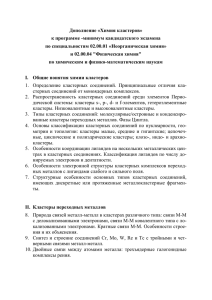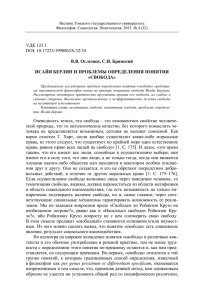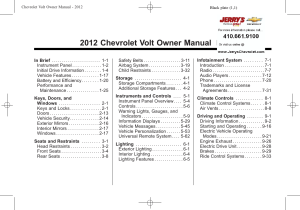948-Article Text-1993-1-10-20180408
реклама
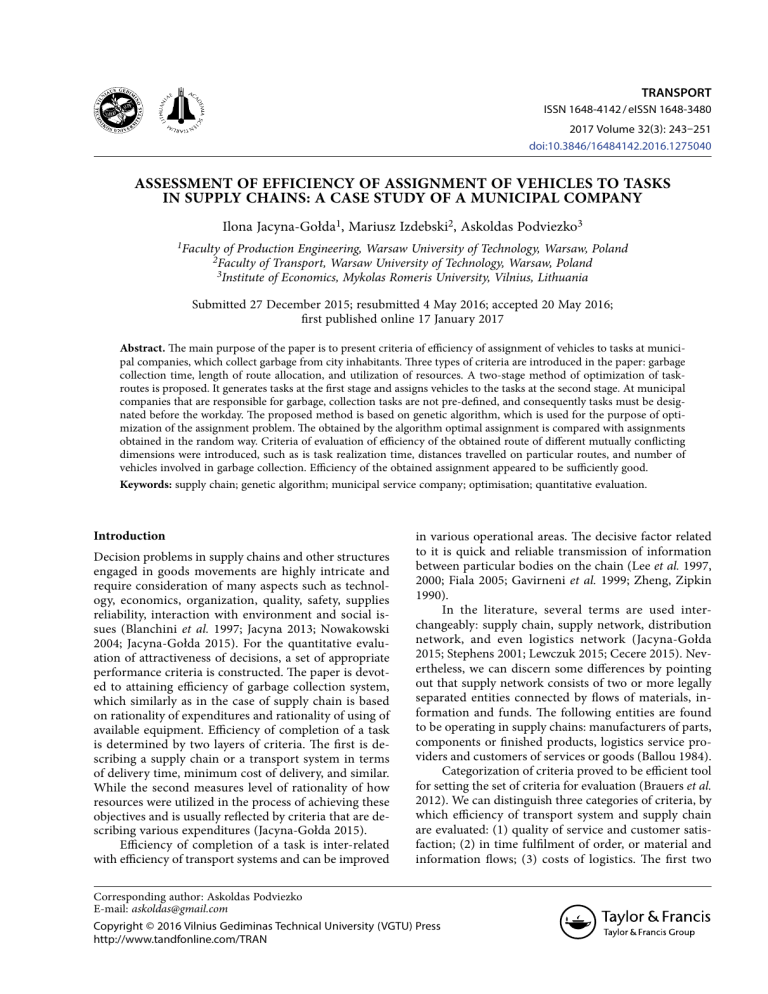
TRANSPORT ISSN 1648-4142 / eISSN 1648-3480 2017 Volume 32(3): 243–251 doi:10.3846/16484142.2016.1275040 ASSESSMENT OF EFFICIENCY OF ASSIGNMENT OF VEHICLES TO TASKS IN SUPPLY CHAINS: A CASE STUDY OF A MUNICIPAL COMPANY Ilona Jacyna-Gołda1, Mariusz Izdebski2, Askoldas Podviezko3 1Faculty of Production Engineering, Warsaw University of Technology, Warsaw, Poland of Transport, Warsaw University of Technology, Warsaw, Poland 3Institute of Economics, Mykolas Romeris University, Vilnius, Lithuania 2Faculty Submitted 27 December 2015; resubmitted 4 May 2016; accepted 20 May 2016; first published online 17 January 2017 Abstract. The main purpose of the paper is to present criteria of efficiency of assignment of vehicles to tasks at municipal companies, which collect garbage from city inhabitants. Three types of criteria are introduced in the paper: garbage collection time, length of route allocation, and utilization of resources. A two-stage method of optimization of taskroutes is proposed. It generates tasks at the first stage and assigns vehicles to the tasks at the second stage. At municipal companies that are responsible for garbage, collection tasks are not pre-defined, and consequently tasks must be designated before the workday. The proposed method is based on genetic algorithm, which is used for the purpose of optimization of the assignment problem. The obtained by the algorithm optimal assignment is compared with assignments obtained in the random way. Criteria of evaluation of efficiency of the obtained route of different mutually conflicting dimensions were introduced, such as is task realization time, distances travelled on particular routes, and number of vehicles involved in garbage collection. Efficiency of the obtained assignment appeared to be sufficiently good. Keywords: supply chain; genetic algorithm; municipal service company; optimisation; quantitative evaluation. Introduction Decision problems in supply chains and other structures engaged in goods movements are highly intricate and require consideration of many aspects such as technology, economics, organization, quality, safety, supplies reliability, interaction with environment and social issues (Blanchini et al. 1997; Jacyna 2013; Nowakowski 2004; Jacyna-Gołda 2015). For the quantitative evaluation of attractiveness of decisions, a set of appropriate performance criteria is constructed. The paper is devoted to attaining efficiency of garbage collection system, which similarly as in the case of supply chain is based on rationality of expenditures and rationality of using of available equipment. Efficiency of completion of a task is determined by two layers of criteria. The first is describing a supply chain or a transport system in terms of delivery time, minimum cost of delivery, and similar. While the second measures level of rationality of how resources were utilized in the process of achieving these objectives and is usually reflected by criteria that are describing various expenditures (Jacyna-Gołda 2015). Efficiency of completion of a task is inter-related with efficiency of transport systems and can be improved in various operational areas. The decisive factor related to it is quick and reliable transmission of information between particular bodies on the chain (Lee et al. 1997, 2000; Fiala 2005; Gavirneni et al. 1999; Zheng, Zipkin 1990). In the literature, several terms are used interchangeably: supply chain, supply network, distribution network, and even logistics network (Jacyna-Gołda 2015; Stephens 2001; Lewczuk 2015; Cecere 2015). Nevertheless, we can discern some differences by pointing out that supply network consists of two or more legally separated entities connected by flows of materials, information and funds. The following entities are found to be operating in supply chains: manufacturers of parts, components or finished products, logistics service providers and customers of services or goods (Ballou 1984). Categorization of criteria proved to be efficient tool for setting the set of criteria for evaluation (Brauers et al. 2012). We can distinguish three categories of criteria, by which efficiency of transport system and supply chain are evaluated: (1) quality of service and customer satisfaction; (2) in time fulfilment of order, or material and information flows; (3) costs of logistics. The first two Corresponding author: Askoldas Podviezko E-mail: [email protected] Copyright © 2016 Vilnius Gediminas Technical University (VGTU) Press http://www.tandfonline.com/TRAN 244 I. Jacyna-Gołda et al. Assessment of efficiency of assignment of vehicles to tasks in supply chains ... criteria reflect the degree of meeting customers’ needs, while the third criterion describes efficiency of operation of entities engaged in logistics service. Such criteria are mutually opposing multidimensional criteria, which is often the case in problems of optimization for evaluation of the obtained result (Lazauskaitė et al. 2015; Brauers et al. 2014; Podviezko 2015, 2012; Ginevičius et al. 2012; Podviezko, Podvezko 2014). In Mentzer et al. (2001) nine measures of customer service effectiveness are recognized, among which the most important are the following: –– quality of communication and efficiency of fulfilment of orders by customer service personnel; –– quality and reliability of information about available products offered by manufacturers for customers; –– order accuracy or compliance of received shipments with terms and conditions of orders; –– order proper condition, if consignments delivered to the customers were undamaged; –– order discrepancy handling, if proper actions were undertaken by suppliers in case of errors in delivery and timeliness of deliveries. Similarly, all the three layers of quantitative criteria are used for assessing services provided by municipal companies. As returns are typically not considered in the case of garbage collection, quality of customer service and timely deliveries are used as measures to assess effectiveness of the corresponding supply chain (Cronin, Taylor 1992; Bienstock et al. 1997; Brown et al. 1993; DeCarlo, Leigh 1996; Mardani et al. 2016; Velychko 2015; ElSayed et al. 2016; Zhou et al. 2015). Other effectiveness measures in supply chains are related to warehousing and transport processes, but these are applied to other entities than municipal company. Warehousing and transport processes are seen as the most expensive in supply chains, thus costs induced by these processes are used to evaluate effectiveness of supply chain (Baykasoğlu, Kaplanoğlu 2008; Anderson, Dekker 2009; Suzuki, Dai 2013; Burkard et al. 2012; Lagos et al. 2015). Minimization of transport costs between participants of supply chain and transport destinations in transport system is considered to be the most fundamental factor for improving effectiveness. The task of achieving efficiency of the assignment of vehicles to contracted tasks is the basic decision problem, which is influencing transportation costs. It is the optimization task, which is widely described in the literature (Burkard et al. 2012). The aim is to minimize resources, such as vehicles and workers, required to execute contracted tasks. The classic problem of assignment of resources implies that each task is assigned to exactly one contractor and each contractor performs only one task. The assignment is considered to be efficiently generated when total tasks realization time or realization cost is minimal. Generally speaking, the assignment problem is defined as finding an efficient association of resources with tasks. The problem can be solved in three ways by introducing different combinations of assigned amounts or numbers of tasks to resources as follows: equal number of tasks and resourc- es; larger number of tasks than resources; fewer tasks than resources. In the paper, the problem is attempted by finding the most efficient organization of disposal of vehicles to tasks, which minimize total transport costs (Izdebski, Jacyna 2014a). Allocating vehicles to transport tasks is a complex decision problem affecting correct functioning of supply chains and transport systems. The problem of efficient assignment of vehicles to tasks is similar to the problem of drivers and vehicles scheduling problem. A typical company in transport business would consider it as determining driver’s work schedules (timetables) and assigning drivers to shifts (Cattrysse, Van Wassenhove 1992; Lourenço et al. 2001). The literature refers to such problems as bus driver scheduling problems (Cattrysse, Van Wassenhove 1992) or crew scheduling problems (Freling et al. 1999). Naturally, such problems can also be related to a municipal company. The assignment problem plays a crucial role in determining transportation routes. This type of problem is usually referred to as vehicle scheduling problem (Burkard et al. 2012) and applies to air, railway and road modes of transport. A solution covers a set of routes to be executed in the most rational way. Order of the routs assigned to a vehicle is important, as a proper choice of the order should minimize the total cost of the travel (Raff 1983; Bodin, Golden 1981; Freling et al. 1999). The other aspect of efficiency is finding the minimal number of transport means (cars, planes, trains etc.), which would cover all the routes required. The paper attempts to investigate the problem of assigning vehicles to tasks at municipal companies. It is classified as a vehicle-scheduling problem. The paper also attempts to find the ways to assess the effectiveness of assignments of vehicles to tasks in such companies and introduces quantitative criteria for such assessment. 1. Assigning Vehicles to Tasks at Municipal Companies The problem of assigning vehicles to tasks at municipal companies, which operate in the municipal garbage collection system for individual citizens is broadly discussed in Jacyna and Izdebski (2014), Izdebski and Jacyna (2014b), Izdebski (2014). Municipal waste is collected by specialized vehicles, garbage trucks of different capacities, and brought to the municipal waste management plant (a garbage dump or a landfill). Municipal utilities have their own transport base, where vehicles start and complete execution of all required tasks. Graphical interpretation of the assignment problem at municipal companies is shown on Fig. 1. In general, the problem of assignment of garbage trucks to tasks at municipal companies boils down to finding solutions which lower operation costs. This means that the routes should be as short as possible (green dashed line on Fig. 1). Complexity of the problem arises at every loading and unloading point, as well as at the point where the vehicle starts operation, and at the point where a vehicle is dumping the garbage to the Transport, 2017, 32(3): 243–251 p1–3 p1–2 245 p1–1 a – start of tasks b – ending point p – intermediate point b1 a2 a1 a3 p3–1 B b2 p3–2 b3 p2 W Task 1 Assignment route b4 Task 2 Base a4 Task 3 Task 4 Landfill Fig. 1. The graphical interpretation of the assignment problem at municipal services companies (source: created by the authors) landfill. The points of tasks can be reached in two ways: directly from the plant or from the base. On Fig. 1, such loading and unloading points are depicted, for which garbage-loading route indices are used as follows: –– B – the base, after leaving which the vehicle starts garbage collection; –– the first garbage collection point of each route is denoted as a1, a2, a3, a4; it is also the beginning of the task; –– the last garbage collection point is denoted as b1, b2, b3, b4; here the vehicle completes the garbage loading route and heads to the landfill, which is denoted as the point W; –– for the intermediate points of the garbage loading route p1, p2, p3 indices are used followed by their sequential number. The transport task in which garbage is collected into one large capacity container is set by only two operations: loading the whole container onto the vehicle and transporting it to the dumping point. In contrast, in the case when small capacity containers as typical home bins are used, collection of garbage is carried out by visiting various estates (households) and sequential loading waste on the garbage truck. When the truck is fully loaded, it goes to the dumping point. Therefore, in the second case the minimal route of the garbage truck (in terms of travel time or distance, depending on the optimization criterion) between loading points must be determined. In general, a transport task is defined as obtaining the optimal route of conveying a load from the origin to the destination point. Setting points of origin to define tasks for municipal companies is problematic since the points may not be at the same place. The unloading point is typically located at a fixed spot, a garbage dump, but collection of garbage requires visiting of a number of loading points until the vehicle is fully loaded. Setting the initial and the last points requires attention, because location of the initial point affects the choice of subsequent points, while location of the final point of the route determines the length of the route of the vehicle to the dumping point. Non-rational selection of the initial and the last points influences the length of the whole collection route. As at municipal companies tasks are not pre-defined, tasks must be designated before the workday. Consequently, a task can be designated to a vehicle only when all points in the sequence have been derived. An additional aspect, which discerns the problem of assignment of garbage truck to tasks at municipal companies, is the ultimate goal of minimization of total operating costs of the company. Optimization of garbage collection routes for each vehicle (in terms of criteria gauging time or distance) is not necessarily minimizing the total distance travelled by all vehicles of the company. Thus, in the problem of optimization of assignment of tasks the solution requires finding not only the minimizing loading route for each vehicle, but also the optimal total route of vehicles, taking into account minimization of the distances to loading and dumping points. 2. Criteria of Assessment of Effectiveness of Assignment of Vehicles to Tasks in a Municipal Company The problem of assignment of vehicles to tasks at municipal companies appears to be a complex decisionmaking optimization problem. Designating the tasks, namely garbage collection routes, is a NP-hard problem, which is closely related to Travelling Salesman Problem (TSP) and the Chinese Postman Problem (CPP) (Beliën et al. 2014). Such a complex task requires setting criteria of assessment of attractiveness of derived solution. Such core criteria as total garbage collection time and total length of routes are chosen for this purpose. Total time of garbage collection determines the number of required drivers to be simultaneously employed at the company and thus it affects magnitude of wage expenses. We pay attention to such particularities as working time limits imposed by the law and to possibilities of extending operating time by implementing the two-shift workday. On the other hand, the length of waste collection routes affects fuel expenditures. However, the minimal waste collection route is not always associated with the minimal operating time. As a simple example could serve a situation of peak hours when a driver usually selects a path with a lower traffic density as the most efficient one. As a consequence, choosing routes with minimum traffic for the purpose of bypassing traffic jams could reduce collection time, but the distance and fuel expenditures may increase as a consequence. A longer path with less traffic makes sense only, when commuting time becomes shorter than the time wasted in a traffic jam on a shorter route. I. Jacyna-Gołda et al. Assessment of efficiency of assignment of vehicles to tasks in supply chains ... 246 To assess effectiveness of an assignment of vehicles to tasks at municipal companies three criteria are proposed: total garbage collection time, route length and resources utilization. The criterion of garbage collection time Tcoll is defined as follows: coll T= t opt ⋅ 100% , t (1) where: topt is the optimal or minimal time of collection; t is the actual time of collection in the assessed assignment. The criterion Tcoll takes values within the interval [0,1]. Desired values should be as close to unity as possible. Tcoll is a maximizing criterion, as its smaller values represent the situation of increased operating costs; longer time of collection associated with higher fuel consumption; increased wage expenses. The two-stage method for determining the optimal collection time topt is presented in section 3. It serves as a reference point for comparing actual times elicited from performing assignments. The optimal waste collection time is determined for a given region of collection and is a constant. The task of obtaining topt requires setting of the following notations (Izdebski 2014): – W = {w} is the set of all points in the transportation network (the base, collection points, garbage dump, starting and ending points of routes, intermediate points of routes); – RL = {rl} is the set of types of collected waste as glass, paper, etc.; – LAP = lap ai , w j are matrices of numbers of connections between the starting loading points and the intermediate loading points on the loading routes; – LAK = lak ( ai , bm ) is the matrix of numbers of connections between the starting points and ending points of the loading routes; – LPK = lpk w j , bm are matrices of numbers of connections between the intermediate points and ending points of the loading routes; – LPP = lpp w j , w ′j are matrices of numbers of connections between different intermediate points of the loading routes; – LWA = lwa ( ai , L ) are matrices of numbers of connections between the landfill L and the starting loading point on the loading routes; – LWB = lwb ( L, B ) are matrices of numbers of connections between the landfill L and the base B; – LBA = lba ( ai , B ) are matrices of numbers of connections between the base and the starting point of the loading routes; – LKW = lkw ( bi , L ) are matrices of numbers of runs between ending garbage collecting points and the landfill; ( ( ( ) ) ) – K = {k} is the matrix of drivers who are performing tasks in a workday; – LKN = lkn ( L, B ) , k are matrices of numbers of runs between the landfill and the base performed by k-th driver; – Ξ ( st ) =( ξ, st ) is the set of means of transport of the st-th type. The following are the matrixes containing driving times of the k-th driver between specified points: – TJ1 = tj1 ( B, ai ) , k – between the base and the first point of the collection route of the task; – TJ 2 = tj2 ( L, ai ) , k – between the landfill and the first point of the collection route; – TJ 3 = tj3 ( L, bm ) , k – between the ending point of the collection route and the landfill; – TJ 4 = tj4 ( L, B ) , k – between the landfill and the base; – TJ 5 = tj5 ai , w j , k – between the first point of the collection route and intermediary collection route points; – TJ 6 = tj6 w j1 , w j 2 , k – between intermedi ary collection route points; – TJ 7 = tj7 w j , bm , k – between collection route waypoints and the ending point of the collection route; – TJ 8 = tj8 ( ai , bm ) , k – between the starting loading point and the ending point of the collection route. Decision variables depend on the part of the route. They are equal to values of the binary function X ( w , w′ ) , ( ξ, st ) , rl , which equals to 1 when transport of the rl-th type of waste of the ξ-th vehicle of the st-th type runs between the w-th and w′-th nodes; otherwise equals 0. Notations of the decision variables are as follows: = – X1 X ( w , w ′ ) , ( ξ, st ) , rl – between the first point of the collection route and collection route waypoints; = – X 2 X ( w , w ′ ) , ( ξ, st ) , rl – between collec tion route waypoints; = – X 3 X ( w , w ′ ) , ( ξ, st ) , rl – between collec tion route waypoints and the ending point of the collection route; = – X 4 X ( w , w ′ ) , ( ξ, st ) , rl – between garbage dumping point and the first point of the collection route; = – X 5 X ( w , w ′ ) , ( ξ, st ) , rl – between the base and the first point of the collection route; = – X 6 X ( w , w ′ ) , ( ξ, st ) , rl – between the end ing point of the collection route and garbage dumping point; = – X 7 X ( w , w ' ) , ( ξ, st ) , rl – between garbage dumping point and the base. { } ( ) ( ) ( ) ( ) (( ) ) (( ) ) (( ) ) ( ) ( ) ( ) ( ) ( ) ( ) ( ) ( ) ( ) Transport, 2017, 32(3): 243–251 247 topt is found by minimizing the following expression: ∑ ∑ ∑ ∑ X1 ( w, w ′) , ( ξ, st ) , rl × rl∈RL ( ξ, st )∈Ξ k∈K ( w ,w ′ )∈LAP TJ 5 ( w , w ′ ) , k + ( ( ) ( ) ) ( ) ( ) ( ) ( ) ( ) ( ) ( ) ∑ X 2 ( w , w ′ ) , ( ξ, st ) , rl ⋅ TJ 6 ( w , w ′ ) , k + ∑ X 3 ( w , w ′ ) , ( ξ, st ) , rl ⋅ TJ 7 ( w , w ′ ) , k + ∑ X 0 ( w , w ′ ) , ( ξ, st ) , rl ⋅ TJ 8 ( w , w ′ ) , k + ∑ X 5 ( w , w ′ ) , ( ξ, st ) , rl ⋅ TJ1 ( w , w ′ ) , k + ∑ X 4 ( w , w ′ ) , ( ξ, st ) , rl ⋅TJ 2 ( w , w ′ ) , k + ∑ X 6 ( w , w ′ ) , ( ξ, st ) , rl ⋅ TJ 3 ( w , w ′ ) , k + ∑ LKN ( w , w ′ ) , k ⋅ X 7 ( w , w ′ ) , ( ξ, st ) , rl × ( w ,w′)∈LPP ( w ,w′)∈LPK ( w ,w′)∈LAK ( w ,w′)∈LBA ( w ,w′)∈LWA ( w ,w′)∈LKW ( w ,w′)∈LWB ( ) ( ) ( ) ( ) ( ) )) ( TJ 4 ( w , w ′ ) , k → min . For the quantitative estimation of efficiency of assignment of vehicles to tasks, which would also encompass fuel expenditures, criterion gauging the length of route is introduced: ( )) d opt ⋅ 100% , d where: dopt is the optimal (or minimal) length of garbage collection route; d is length of garbage collection route of the assessed assignment. The criterion takes values within the range [0,1] and is of the maximizing direction. Its declining values indicate increased fuel consumption and fuel-related expenses; and increased maintenance costs. Parameters may have considerable effect on results of evaluation (Podvezko, Podviezko 2010); a two-stage method of determining dopt is presented in section 3. It is similar to the one used for waste collection time criterion. Parameter dopt is set by the same formula as for waste collection time criterion. The difference is in using the decision variable d ( w , w ′ ) , k that is describing distances between nodal elements of the network instead of the variable that is defining the travel time. Finally, for gauging efficiency of utilization of resources we introduce the criterion, which comprise both wage and vehicle maintenance expenses. The larger is the number of vehicles required for collection of waste, the larger number of drivers is needed, the higher are wage expenses. Larger number of vehicles create additional maintenance costs. The criterion of utilization of resources NPis defined as follows: = Dtr ( ) nopt ⋅ 100% , n where: nopt is the optimal (minimal) number of vehicles required for performing garbage collection, n is the P N = number of vehicles used in the assessed assignment. nopt takes values within the interval [0,1] and is the maximizing criterion. The smaller is the value of nopt, the larger are maintenance and wage expenses. The two-stage method for determining dopt is presented in section 3. It is worth to note that changing value of one criterion may lead to a change of value of other criteria. Consequently, costs described by such criteria may change. For example, reduction of value of the resource utilization criterion increases the number of vehicles and drivers involved in waste collection, nevertheless duration of collection cycle shortens at the same time. 3. The Two-Stage Method of Obtaining Parameters for Criteria of Effectiveness The proposed method for obtaining parameters for criteria of effectiveness topt, dopt and nopt contains two stages. Collection tasks are defined at the first stage, while vehicles are assigned to the described above tasks at the second stage. The generated assignment is considered as optimal and is used to set the above-mentioned parameters. We define aggregated collecting points as a set of individual collecting points (e.g. small containers/bins) found on the same direction of a street or its section. Naturally, changing of direction by the vehicle on the section is not rational, consequently it is not allowed. Decision about next-to-take individual collecting points can be made only upon reaching subsequent nodes (crossroads, intersections etc.) by the garbage truck; and direction can be altered there by decision of the driver. Thus, the vehicle will perform garbage collection until all containers that are present in the aggregated collection point, are empty. Naturally, capacity of any aggregated collecting point cannot exceed minimum capacity of the vehicle in the company. Aggregated collecting points are demonstrated on Fig. 2. At the first stage of the method, the minimal taskroute has to be derived. It will be constructed using genetic algorithm over a chromosome by making Partially Mapped Crossover (PMX) permutations and mutations that randomly change two genes in the chromosome. Roulette wheel technique is used. The resulting taskroute must embrace all aggregated collecting points in the network. The task of the genetic algorithm is to find a set of aggregated loading points, which would make minimal the total distance or traveling time of the route. A sample of the chromosome is presented on Fig. 3. The blue gene represents the starting point of the task-route; green genes represent collecting points (intermediate points of the task-route) and the red gene represents exit point of the collection route, from which truck goes to the garbage dump. Now particular transport tasks can be determined by choosing exit points from which the garbage truck goes to the garbage dump, all intermediate points, and the starting point. Exit points divide the task-route into sections in which total collected garbage volume does not exceed the truck capacity. 248 I. Jacyna-Gołda et al. Assessment of efficiency of assignment of vehicles to tasks in supply chains ... Fig. 2. Aggregated collecting points (source: created by the authors; Google Earth software was used) Fig. 3. Construction of minimum task-route (source: created by the authors) Defining transport tasks starts from dividing the minimal task-route into sections (collection routes) with total amount of garbage to be collected on such sections not to exceed vehicle capacity, but to be as close to this capacity as possible. The municipal service company owns vehicles of different capacity, but initially all the tasks are adapted to the capacity of the vehicles with the largest capacity. It guarantees servicing the largest possible number of loading points and the smallest number of exits to the garbage dump. Prevailing time constraints, such as collection time allowed and working time of drivers, determine the set of vehicles, which should be allocated to perform the whole task of collection of garbage, at the second stage. If the number of vehicles with the maximal capacity is insufficient to perform tasks due to the constraints, the stage of designating tasks needs to be repeated again. Then the new minimal task-route must be designated from the remaining aggregated collecting points, which were not yet collected by the vehicle with the maximal capacity. The route then is divided into sections, which match the next largest vehicle of a lower capacity. The procedure is repeated for the trucks of lower capacity, if necessary, until all garbage collection points are serviced. If available vehicles at the municipal services company cannot perform the tasks within time limits then it can be concluded that the number of available vehicles is insufficient to perform the whole garbage collection. At the second stage of the method, transport tasks obtained at the first stage are used, from which the minimal assignment route is constructed. The latter route is required to derive parameters topt, dopt and nopt. The minimal assignment route has the starting point the base; further, it comprises all the tasks required to be performed. The minimal assignment route is again found using genetic algorithm constructed similarly as in the first stage. The quantitative criterion that reveals attractiveness of the route is either Tcoll or Dtr depending, if it is used for obtaining the minimal time required to complete all tasks, or for the minimal distance covered. The chromosome representing the assignment-route is presented in Fig. 4a, where tasks are depicted as blue genes and bases as green genes. Genetic algorithm with permutations of points of the route is used for configuring the sequence comprising the base and tasks for the purpose of achieving an assignment of minimal length and travel time. On Fig. 4b–d we can observe elementary assignment-routes, which are adopted by cutting them from the minimal assignment-route; each elementary assignment-route begins and ends at the base. Such elementary assignment-routes are added up in random to form the complete route of each vehicle, while constrains for task duration, driving time, and daily working time are met. If such constraints were not fulfilled, another vehicle is assigned to this elementary assignment-route. After completion of the process of the assignment of the vehicles to elementary assignment-routes and obtaining results, one can derive the minimum number of vehicles carrying out all the tasks, as it will be shown in the example presented in section 4. The procedure is applied for each size of the task. Consequently, parameters topt, dopt and the minimal number of vehicles are obtained for each task separately. In the case when tasks appear to be combined, all parameters and vehicles are added. a) b) c) d) Fig. 4. Routes: a – assignment route; b–d – elementary assignment routes (source: created by the authors) Transport, 2017, 32(3): 243–251 249 4. Practical Verification of the Method of Choosing the Optimal Assignment of Tasks to Vehicles Optimal parameters of the algorithm as selection, crossover and mutation operators, number of iterations and population size were found experimentally. Parameters are recognized as best when algorithm generates the minimal task and assignment routes. As there are 92 aggregated collection points (Fig. 2) the number of combinations of the routes is as high as 92! Based on the minimal task-route, 30 tasks were generated. The maximal length of the assignment-route appeared to be 61 points; consequently, the maximal length of the chromosome corresponding to the base-task-base sequence was limited to the latter number. As the first and the last points refer to the base, the total number of combinations of assignment-routes appears to be 59! A sample of an assignment-route and its tasks is shown on Fig. 5. Tasks are denoted by blue lines, while assignment routes are denoted by dashed green lines. In order to verify results, the method was launched 10 times, in order to generate assignment-routes in the random way. Comparison to the random solutions was made each time. Obtained assignments of the minimal length of assignment-route are presented in Table 1, while assignments with minimum time are presented in Table 2. Table 3 shows resulting minimal number of vehicles. We note that assignments in Table 1 are not congruent to those in Table 2 because they were determined using different criteria functions for time and distance. Again, we note that the smallest number of Fig. 5. Garbage collection routes (source: created by the authors) vehicles was determined from assignment-routes of the minimal length. From Tables 1–3 we derive the optimal reference parameters: t opt = 6.184 ; d opt = 359.2 ; nopt = 4 . Comparison of the results obtained by applying optimal reference parameters with the parameters generated in random are presented in Table 4, which reveals that the optimal allocation was not reached. Yet the criteria that reflect attractiveness of the derived routes of garbage collection time; length of route; and utilization of resources show a rather good result of comparison with the optimal reference parameters, 73.79% in average. Table 1. The length of minimal assignment-route The number of attempts 1 2 3 4 5 6 7 8 9 10 Average value Random method [km] 379.4 383.1 383.3 380.2 379.7 381.5 384.4 381.9 383.7 379 381.6 Proposed method [km] 359.2 369.1 363.8 370.1 369.9 368.3 369.8 369.8 365 365.8 366.9 7 8 9 10 Average value Type Table 2. The duration of minimal assignment-route Type The number of attempts 1 2 3 4 5 6 Random method [h] 7.93 8.662 8.666 9.604 7.594 8.63 8.678 10.698 11.674 8.58 7.632 Proposed method [h] 6.184 7.332 7.276 7.102 6.398 7.166 6.396 7.196 7.33 7.116 6.338 8 9 10 Average value Table 3. Minimal number of vehicles Type The number of attempts 1 2 3 4 5 6 7 Random method 6 7 6 7 9 6 7 8 7 7 7 Proposed method 5 4 4 7 5 7 5 4 5 4 5 Table 4. Assignment performance indicators Parameter Tcoll [%] Dtr [%] NP [%] The number of attempts 1 2 3 4 5 6 7 8 9 10 77.98 71.39 71.35 64.38 81.43 71.65 71.26 57.80 52.97 72.07 94.67 93.76 93.71 94.47 94.6 94.15 93.44 94.05 93.61 94.77 66.66 57.14 66.66 57.14 44.44 66.66 57.14 50 57.14 57.14 250 I. Jacyna-Gołda et al. Assessment of efficiency of assignment of vehicles to tasks in supply chains ... As the method applies classic genetic algorithm, the parameters can possibly be improved by trying to use alternative selection or crossover mechanisms or multiple criteria evaluation methods in further research. Conclusions The paper attempts the problem of optimization of assignment of tasks of collecting garbage by municipal services companies and is searching for tools, which are the most appropriate for tackling this problem. A method was proposed and used in the paper for obtaining parameters, which assess effectiveness of an assignment of vehicles to tasks at municipal companies. Parameters serve as benchmarks for obtaining optimal assignment of tasks to vehicles. Genetic algorithms are found within a subset of heuristic algorithms, which create either near optimum or optimal solutions, but often confine themselves to narrow areas of the search. Despite this, heuristics algorithms are successfully used in many optimization problems. Taking into account the scale of the problem of designating the task and assignment route, as in our case, when 92 possible task routes and 59 assignment routes produce 92! and 59! combinations, the model generated a near-optimum solution. Assignment of derived task-routes for municipal companies needs a complex approach. Therefore, the paper goes beyond cost-efficiency analysis and suggests several criteria, which reflect garbage collection time, length of route, and utilization of resources. The cumulative criteria comprising garbage collection time; length of route; and utilization of resources that reflect attractiveness of the derived 10 routes show a rather good result of 73.79% in average compared to the optimal solution. References Anderson, S. W.; Dekker, H. C. 2009. Strategic cost management in supply chains, part 2: executional cost management, Accounting Horizons 23(3): 289–305. http://doi.org/10.2308/acch.2009.23.3.289 Ballou, R. H. 1984. DISPLAN: a multiproduct plant/warehouse location model with nonlinear inventory costs, Journal of Operations Management 5(1): 75–90. http://doi.org/10.1016/0272-6963(84)90008-1 Baykasoğlu, A.; Kaplanoğlu, V. 2008. Application of activitybased costing to a land transportation company: a case study, International Journal of Production Economics 116(2): 308–324. http://doi.org/10.1016/j.ijpe.2008.08.049 Beliën, J.; De Boeck, L.; Van Ackere, J. 2014. Municipal solid waste collection and management problems: a literature review, Transportation Science 48(1): 78–102. http://doi.org/10.1287/trsc.1120.0448 Bienstock, C. C.; Mentzer, J. T.; Bird, M. M. 1997. Measuring physical distribution service quality, Journal of the Academy of Marketing Science 25(1): 31–44. http://doi.org/10.1007/BF02894507 Blanchini, F.; Rinaldi, F.; Ukovich, W. 1997. A network design problem for a distribution system with uncertain demands, SIAM Journal on Optimization 7(2): 560–578. http://doi.org/10.1137/S1052623494266262 Bodin, L.; Golden, B. 1981. Classification in vehicle routing and scheduling, Networks 11(2): 97–108. http://doi.org/10.1002/net.3230110204 Brauers, W. K. M.; Ginevičius, R.; Podviezko, A. 2014. Development of a methodology of evaluation of financial stability of commercial banks, Panoeconomicus 61(3): 349–367. http://doi.org/10.2298/PAN1403349B Brauers, W. K. M.; Ginevičius, R.; Podviezko, A. 2012. Evaluation of performance of lithuanian commercial banks by multi-objective optimization, in The 7th International Scientific Conference ‘Business and Management 2012’: Selected Papers, 10–11 May 2012, Vilnius, Lithuania, 1042–1049. http://doi.org/10.3846/bm.2012.133 Brown, T. J.; Churchill, G. A.; Peter, J. P. 1993. Improving the measurement of service quality, Journal of Retailing 69(1): 127–139. http://doi.org/10.1016/S0022-4359(05)80006-5 Burkard, R.; Dell’Amico, M.; Martello, S. 2012. Assignment Problems. 2nd edition. Society for Industrial and Applied Mathematics. 415 p. http://doi.org/10.1137/1.9781611972238 Cattrysse, D. G.; Van Wassenhove, L. N. 1992. A survey of algorithms for the generalized assignment problem, European Journal of Operational Research 60(3): 260–272. http://doi.org/10.1016/0377-2217(92)90077-M Cecere, L. M. 2015. Supply Chain Metrics that Matter. John Wiley & Sons Inc. 400 p. Cronin, J. J.; Taylor, S. A. 1992. Measuring service quality: a reexamination and extension, Journal of Marketing 56(3): 55–68. http://doi.org/10.2307/1252296 DeCarlo, T. E.; Leigh, T. W. 1996. Impact of salesperson attraction on sales managers’ attributions and feedback, Journal of Marketing 60(2): 47–66. http://doi.org/10.2307/1251930 ElSayed, A.; Kongar, E.; Gupta, S. M. 2016. Fuzzy linear physical programming for multiple criteria decision-making under uncertainty, International Journal of Computers Communications & Control 11(1): 26–38. http://doi.org/10.15837/ijccc.2016.1.2083 Fiala, P. 2005. Information sharing in supply chains, Omega 33(5): 419–423. http://doi.org/10.1016/j.omega.2004.07.006 Freling, R.; Wagelmans, A. P. M.; Paixão, J. M. P. 1999. An overview of models and techniques for integrating vehicle and crew scheduling, in N. H. M. Wilson (Ed.). ComputerAided Transit Scheduling, 441–460, http://doi.org/10.1007/978-3-642-85970-0_21 Gavirneni, S.; Kapuscinski, R.; Tayur, S. 1999. Value of information in capacitated supply chains, Management Science 45(1): 16–24. http://doi.org/10.1287/mnsc.45.1.16 Ginevičius, R.; Podvezko, V.; Podviezko, A. 2012. Evaluation of isolated socio-economical processes by a multi-criteria decision aid method ESP, in The 7th International Scientific Conference ‘Business and Management 2012’: Selected Papers, 10–11 May 2012, Vilnius, Lithuania, 1083–1089. http://doi.org/10.3846/bm.2012.138 Izdebski, M. 2014. The use of heuristic algorithms to optimize the transport issues on the example of municipal services companies, Archives of Transport 29(1): 27–36. http://doi.org/10.5604/08669546.1146961 Izdebski, M.; Jacyna, M. 2014a. Some aspects of the application of genetic algorithm for solving the assignment problem of tasks to resources in a transport company, Logistics and Transport 21(1): 13–20. Izdebski, M.; Jacyna, M. 2014b. Use of computer assistance in order to designate the tasks in the municipal services companies, Journal of Kones 21(2): 105–112. http://doi.org/10.5604/12314005.1133882 Transport, 2017, 32(3): 243–251 Jacyna, M. 2013. Cargo flow distribution on the transportation network of the national logistic system, International Journal of Logistics Systems and Management 15(2–3): 197–218. http://doi.org/10.1504/IJLSM.2013.053767 Jacyna, M.; Izdebski, M. 2014. The ant algorithm for solving the assignment of vehicles to tasks in the municipal services companies, Journal of Kones 21(2): 113–119. http://doi.org/10.5604/12314005.1133884 Jacyna-Gołda, I. 2015. Evaluation of operational reliability of the supply chain in terms of the control and management of logistics processes, in T. Nowakowski, M. Młyńczak, A. Jodejko-Pietruczuk, S. Werbińska-Wojciechowska (Eds.). Safety and Reliability: Methodology and Applications, 549–558. http://doi.org/10.1201/b17399-78 Lagos, C.; Paredes, F.; Niklander, S.; Cabrera, E. 2015. Solving a distribution network design problem by combining ant colony systems and Lagrangian relaxatio, Studies in Informatics and Control 24(3): 251–260. Lazauskaitė, D.; Burinskienė, M.; Podvezko, V. 2015. Subjectively and objectively integrated assessment of the quality indices of the suburban residential environment, International Journal of Strategic Property Management 19(3): 297–308. http://doi.org/10.3846/1648715X.2015.1051164 Lee, H. L.; Padmanabhan, V.; Whang, S. 1997. Information distortion in a supply chain: the Bullwhip effect, Management Science 43(4): 546–558. http://doi.org/10.1287/mnsc.43.4.546 Lee, H. L.; So, K. C.; Tang, C. S. 2000. The value of information sharing in a two-level supply chain, Management Science 46(5): 626–643. http://doi.org/10.1287/mnsc.46.5.626.12047 Lewczuk, K. 2015. The concept of genetic programming in organizing internal transport processes, Archives of Transport 34(2): 61–74. http://doi.org/10.5604/08669546.1169213 Lourenço, H. R.; Paixão, J. P.; Portugal, R. 2001. Multiobjective metaheuristics for the bus driver scheduling problem, Transportation Science 35(3): 331–343. http://doi.org/10.1287/trsc.35.3.331.10147 Mardani, A.; Zavadskas, E. K.; Govindan, K.; Amat Senin, A.; Jusoh, A. 2016. VIKOR technique: a systematic review of the state of the art literature on methodologies and applications, Sustainability 8(1): 1–38. http://doi.org/10.3390/su8010037 Mentzer, J. T.; Flint, D. J.; Hult, G. T. M. 2001. Logistics service quality as a segment-customized process, Journal of Marketing 65(4): 82–104. http://doi.org/10.1509/jmkg.65.4.82.18390 Nowakowski, T. 2004. Reliability model of combined transportation system, in C. Spitzer, U. Schmocker, V. N. Dang (Eds.). Probabilistic Safety Assessment and Management, 2012– 2017. http://doi.org/10.1007/978-0-85729-410-4_323 Podvezko, V.; Podviezko, A. 2010. Use and choice of preference functions for evaluation of characteristics of socioeconomical processes, in The 6th International Scientific Conference ‘Business and Management 2010’: Selected Papers, 13–14 May 2010, Vilnius, Lithuania, 1066–1071. http://doi.org/10.3846/bm.2010.143 Podviezko, A. 2012. Augmenting multicriteria decision aid methods by graphical and analytical reporting tools, Lecture Notes in Business Information Processing 106: 236–251. http://doi.org/10.1007/978-3-642-29231-6_19 Podviezko, A. 2015. Type of the Lithuanian financial system, Procedia Economics and Finance 23: 1635–1640. http://doi.org/10.1016/S2212-5671(15)00378-0 251 Podviezko, A.; Podvezko, V. 2014. Absolute and relative evaluation of socio-economic objects based on multiple criteria decision making methods, Engineering Economics 25(5): 522–529. http://doi.org/10.5755/j01.ee.25.5.6624 Raff, S. 1983. Routing and scheduling of vehicles and crews: the state of the art, Computers & Operations Research 10(2): 63–211. http://doi.org/10.1016/0305-0548(83)90030-8 Stephens, S. 2001. Supply chain operations reference model version 5.0: a new tool to improve supply chain efficiency and achieve best practice, Information Systems Frontiers 3(4): 471–476. http://doi.org/10.1023/A:1012881006783 Suzuki, Y.; Dai, J. 2013. Decision support system of truck routing and refueling: a dual-objective approach, Decision Sciences 44(5): 817–842. http://doi.org/10.1111/deci.12029 Velychko, O. 2015. Logistical system Fortschrittzahlen in the management of the supply chain of a multi-functional grain cooperative, Economics and Sociology 8(1): 127–146. http://doi.org/10.14254/2071-789X.2015/8-1/10 Zheng, Y.-S.; Zipkin, P. 1990. A queueing model to analyze the value of centralized inventory information, Operations Research 38(2): 296–307. http://doi.org/10.1287/opre.38.2.296 Zhou, L.; Xu, X.; Deng, S.; Liu, X. 2015. Redesigning a supply chain distribution network: formulation and genetic algorithm-based solution procedure, International Journal of Information Technology & Decision Making 14(4): 847–876. http://doi.org/10.1142/S0219622014500369
